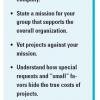The Latest
|
The Metaphors of Scrum[article] We claim that by exploring the metaphors of Scrum, many of the common confusions and debates surrounding Scrum are easier to understand. It has been our experience that people often reach different conclusions with the same words because they are using different metaphors. Additionally, we have observed that that once people become aware of the differences in their applied metaphors they can see each other's point of view more easily. |
||
|
Disciplined Approach to Adopting Agile: Adoption Framework[article] Over the past few years organizations have asked the agile community "Why should we adopt agile practices?" Today, however, they are turning to the agile community, with a different question: "How do we proceed with adopting agile practices?"; Unfortunately, there is no structured approach (at least that is published in the public domain) for agile adoption. The absence of guidance and assistance to organizations pursuing agility is the main problem addressed by this article. |
||
|
Feedback without Fear[magazine] Does the word "feedback" make you cringe? How about "configuration management"? Steve Berczuk has a pain-free plan for using your build environments and software configuration management system to provide the feedback that is essential to a successful agile project. |
||
|
Analysis Paralysis and the Law of Imperfect Plans[magazine] Humans don't handle complexity well, and we certainly can't see the future—which helps explain why our plans and designs so often are flawed. In response to this truth, our guest technical editor offers Payson’s Law of Imperfect Plans. Embracing this law can help you avoid the dreaded analysis paralysis and accept that perfection just isn't possible. |
||
|
A Classic Example[magazine] Many systems architects have a technology—centric view of service-oriented architecture. This article emphasizes the need to understand the business side of SOA before tackling the technology and illustrates this need with a look back in time. |
||
|
Testing Around the World[magazine] These days outsourcing is a pretty familiar concept in this industry. Has globalization hit your company yet? Naomi Mitsumori has been involved in sending testing work offshore, and she has six suggestions that can help you successfully manage the transition. |
Naomi Mitsumori
April 26, 2007 |
|
|
The QA Catchall[magazine] Pssst. You with the QA hat on. Would you be surprised to learn that you probably don't work in a QA department? Find out why what you are doing may not be QA, and discover some practices you can implement to insure that A really does stand for assurance in your organization. |
Alan S. Koch
April 26, 2007 |
|
 |
Attack of the Fifty-Foot Favors[magazine] When your boss constantly has you doing favors for another group, it can get in the way of fulfilling your own responsibilities. Find out how defining your work mission to your manager and illustrating how "small" favors potentially cut into company revenue can help to get everyone on the same page. |
|
|
When in Doubt, Reframe[magazine] One often overlooked testing skill is understanding what our clients are saying--in addition to the words that actually come out of their mouths. Sometimes reframing a seemingly irrational response can lead to a higher level of communication and a more productive relationship. |
||
|
Indulge in Code Review[magazine] Code review is one quality initiative you can't afford to skip. Don't have time for a full-blown, line-by-line review? No problem. Discover how even something as simple as a peer review can benefit your project and ultimately improve your code. |
||
|
Agile Tooling: A Point, Counter-Point Discussion[article] It has been six years since the authoring of the Agile Manifesto, and the technology and tooling landscape has changed since then. This conversation between Ron Jeffriesand Ryan Martens debates the merits and weaknesses of tooling agile. |
||
|
Agile in the Enterprise: How Tools and Processes Enable Interactions[article] Agile development approaches are moving into the mainstream. They are no longer relegated to small co-located teams. Large application development organizations in and outside of IT are betting their businesses on globally distributed teams using agile methods to create and maintain their products. In these organizations, the Agile Manifesto's principal to value individuals and interactions over process and tools is impossible to realize. The complexity created by scale cannot be managed without judicious use of both process and tools. |
||
|
High Performance Agile Teams: An Overview of Collaboration[article] Any team benefits from being highly collaborative. This is especially true in agile development, where the techniques for rapidly building quality software rely on communication and relationships over documentation and process formality. Yet the agile community doesn't have a common definition for what “collaboration” is |
||
|
The Renaissance of Paper for Agile Software Development[article] Fast cars, flat-screen television, high definition gaming consoles, and dual core processor equipped laptops: the amenities of modern technology rule us. Computers are an integral part of our lifestyle and work-life, and many people define themselves by their choice of tools to complete tasks. Those interested in implementing agile frameworks are no exception, often voting to use electronic tools before exploring alternatives. This article is meant for the open-minded, ready-to-explorer surrogate who is not afraid of being a low-tech hippie in times of high-tech espresso machines. |
||
|
Community Developed Builds for the Agile Developer[article] Agile development is a process methodology where, at its core, is the ability for developers to share and test changes in software as rapidly as possible in an efficient but disciplined approach. The Continuous Build process is based on manual scripting and therefore is highly redundant and non-adaptive. Continuous Builds that rely on redundant scripts become road blocks for agile teams when attempting to move quickly from code to deployment. Agile developers must recognize the problems of manual scripting and begin moving toward a non-redundant Community Developed approach to managing the Continuous Build. |







